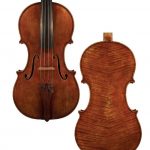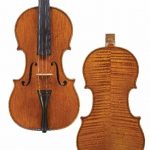The Strad magazine, October 2011 issue: War on worms
Copyright © 2011 Alberto Giordano – The Strad magazine. All rights reserved
Woodworm can wreak havoc with stringed instruments, so it is vital to treat any infestation. Violin maker ALBERTO GIORDANO examines the insect invaders and the damage they cause, and describes a clean, safe and efficient way you can use to strike back.
WOODWORM IS ONE OF THE WORST forms of damage that a stringed instrument can suffer. Unlike other problems, a woodworm attack can produce an irremediable effect on the structure, sound and value of an instrument. Infestation is not only a risk to instruments in museums or collections, or to those simply kept in a loft. It is also a danger for professional players: although sound vibrations may discourage woodworms, regular use will not protect an instrument from infestation.
The risks of an attack occurring depend on the climate and microclimate, and also on the biological condition of the wood used in the instrument and any treatment it has been given in the past. From the Middle Ages to the Renaissance, craftsmen tried to protect wood used for paintings, frames, furniture and then stringed instruments with insecticides that we know little about today. In any case, no historical treatment that we can identify will be enough to protect the wood today from such a dangerous pest. Although wood can resist mechanical and physical damage, sometimes for several centuries, its chemical composition – approximately 40 per cent cellulose, 30 per cent lignin, 25 per cent hemicellulose and 5 per cent resins, fatty acids and other compounds – makes it susceptible to biological attack by fungi and bacteria, which in turn create the perfect conditions for insect infestation. In the case of musical instruments, the chief offenders are members of the beetle family. The adult insects that we see flying out from a hole in the wood are not the ones to worry about: they have completed their biological cycle and are going off to find a place to die. It’s the eggs they leave behind that cause the real damage. The larvae dig tunnels for up to two years as they grow to adulthood, remaining deep within the wood. When it’s time to leave the wood, they choose a hole previously carved by another adult insect. The diameter of the tunnels varies according to the insect species and how big the larvae grow. As they dig, they produce a powder composed of ground wood and excrement, which some species leave inside the tunnels and others eject to the surface.
THE DURATION OF THE CYCLE from egg to adult insect can vary greatly according to the environmental conditions and the insect species. The cycle is usually longer in cold temperatures or outside, whereas in hot, enclosed and humid environments, the cycle can be considerably shorter. Such fertile conditions can produce one or two generations of insect every year, with every female laying up to 30 or 40 eggs, thus dramatically increasing the damage to the wood. One of the most common kinds of wood-boring beetle in North America and Europe is the death watch beetle, so called because of the sound it produces when hitting its head against the wood of the tunnels. This constant, slow hammering is not part of the tunnel-boring action, but a mating call. The beetle usually attacks hardwoods such as maple, walnut, beech and willow, and is particularly aggressive: the female insect can lay up to two hundred eggs and the larvae can live for up to four years. The species thrives in humid conditions and where fungi are present. There are numerous other species of woodworm with varying preferences as to the kind of wood they choose and even the part they prefer to eat, such as the heartwood or the sapwood. Sometimes they dig tunnels only in the grain direction, more often in every direction. Some woodworm prefer their wood fresh, others old and seasoned. Such variables aside, certain conditions are good for every species: darkness, humidity, a mild temperature, and wood with a rough, uneven surface, with old holes or nicks in which the female can easily lay her eggs. One common technique for destroying woodworm in musical instruments is to seal them in containers and then inject a highly poisonous gas that kills anything living inside the wood. But because of recent laws regarding the use of dangerous materials, fewer European companies offer this service, and it is much more difficult to obtain or maintain licenses to use such highly toxic fumigants. For this reason, musicians and violin makers cannot readily rely on this technique today.
THERE IS AN ALTERNATIVE SOLUTION, however, that uses a disinfestation technique researched by the Getty Conservation Institute in Los Angeles that is now widely used by conservationists in museums and libraries. This method uses a modified atmosphere with a low oxygen content, and is based on the principle that every aerobic organism needs oxygen to live, so that if you destroy the oxygen you will destroy any insects as well. Air is composed of 78 per cent nitrogen, 21 per cent oxygen and 1 per cent other gases, so it can be modified either by adding nitrogen, or by absorbing oxygen. In the first case, an electric device can be used to pump nitrogen into a sealed plastic bag, but this machine is expensive, heavy and noisy. The other system, based on oxygen absorption, is more suitable for a violin shop because the materials are more affordable and easier to handle and store: all you need is plastic barrier fi lm for the bag, an electric heat sealer and some oxygen absorber sachets. I learnt the technique from an art restorer in Italy. I watched her sealing a portrait by Rubens and reckoned the process could work well for violins. Indeed, because the technique has been developed to conserve books, paintings on wood, picture frames and furniture, all of which use relatively thick pieces of wood, I thought that it should be even more efficient when applied to hollow and thin-walled objects such as violins and cellos.
THE EQUIPMENT
The most suitable barrier fi lm is made with three layers of plastic sheet, the middle of which is treated with aluminum. Flexible and transparent, the fi lm is easy to handle and cut. A 150m roll of 160cm-width Nitrex barrier fi lm costs around €300. The fi lm can be sealed using an electric heat sealer at a temperature of 180°C. Costing up to €750, the sealer is the most expensive piece of equipment you will need. Developed for the food industry to protect food in sealed containers, oxygen absorbers work through a chemical reaction. They contain fine iron powder that creates a non-toxic oxide (like rust) as it attacks oxygen in the atmosphere. The sachets can reduce the oxygen level to 0.1 per cent in about 24 hours, but the complete disinfestation process will usually take four or five weeks because it is important to reach every corner of the wood, and to kill the eggs hidden in the deepest of holes, especially when they are protected by air bubbles. The sachets do not significantly raise the relative humidity within the bag, but they should not be placed in direct contact with the instrument because they generate heat at the start of the reaction. The sachet packaging in any case protects the contents from escaping, and both the contents and packaging are non-toxic, so they can be handled without gloves and disposed of easily after use. Sachets typically come in packs of 20 (a pack of 20 ATCO oxygen absorbers costs under €20). As you only need one or two sachets to disinfest a violin, and three for a cello, it is important to store the unused sachets in a sealed container. If the sachets are left out, they will be useless after an hour.
THE METHOD
The bag containing the instrument can be sealed without any kind of supporting structure, but I prefer to use a wooden box frame (figure 1) for easier sealing, safer storage, and to help calculate the volume of air inside the bag (the absorption of oxygen will reduce the bag’s volume by one fifth). The transparent plastic barrier fi lm allows you to check on the instrument at any time. For effective sealing, it is best to make the bag with as few joins as possible. If the piece of fi lm is cut longer than the length of the wooden box you can seal it with only three joins – one on the long side and one at either end. To make the sealing process easier, you can clamp the fi lm with pegs to keep the two long edges aligned (figure 2). It only takes two seconds to seal the Nitrex barrier fi lm (figure 3). When you seal the shorter edges, pegs might get in the way, but be extra careful to keep your fingertips away from the heat sealer so that they don’t get burnt (figure 4). When sealing the top of the bag, you can fold the fi lm over and apply extra film if necessary, using adhesive tape. Once the bag is ready, put the oxygen absorbers and the violin inside and then seal up the bag. If you want to monitor the environment in the bag, you can place a thermometer–hygrometer inside (figure 5). When I did this, I measured the initial relative humidity at 56 per cent. After a few hours it had risen to 66 per cent and it stayed there for about 24 hours. Within a few days, the humidity had settled at 60 per cent, and remained at that level for the next five weeks. The key to the success of the whole process is the quality of the sealing. This must be absolutely perfect because even an invisible hole in the bag can compromise the operation. The oxygen absorbers are tested to be high-quality, but to make absolutely sure they are doing their job effectively, it is a good idea to place an Ageless Eye oxygen indicator in the bag. This small tablet constantly monitors the percentage of oxygen, turning pink below 0.1 per cent and returning to blue above 0.5 per cent. Take care to get the sealing right and you will find this system very effective as well as reasonably affordable and totally harmless for the user, as no gases or fumes are released.





